MEET THE YOUNG ECO-WARRIORS FROM GRENADA | #OPBEACHCLEAN
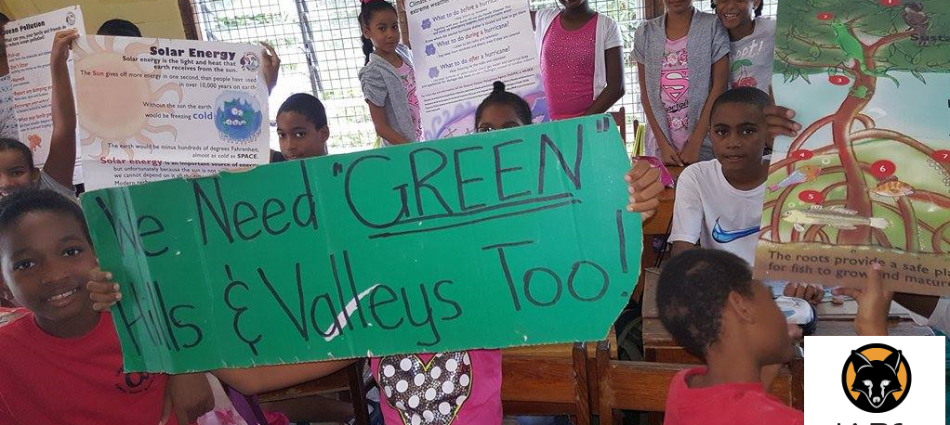

GRENADA ECO WARRIORS, READY FOR OPERATION BEACH CLEAN
GRENADA, West Indies: Meet Grenada’s eco-warriors of the future situated on the small Caribbean West Indies island of Grenada the students of Mt. Parnassus Junior School will be volunteering with their school assistant Mandy pictured below this April 22nd 2017 for the International Earth Day event hosted by I.A.R.F.A. (Image: Mt. Parnassus Junior School Grenada, image copyright.)

Image: Students presenting their mission for Earth Day 2017, Operation Beach Clean.
Operation Beach Clean hosted by myself this April 22nd 2017 has already attracted people from England, Netherlands, Oman, Viet Nam, Thailand, Australia, Greece, and now children from the West Indies island of Grenada which is excellent news.
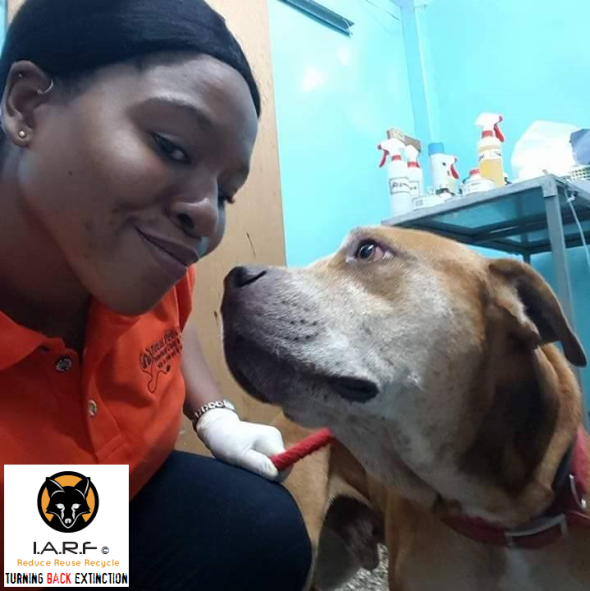
Image: Teaching assistant and teacher organizing and hosting the youth beach clean.
The Mt. Parnassus Junior School students will be taking part in the two day event cleaning a large stretch of their native islands coastline of which its expected a lot of plastic and waste will be collected due to the islands strategic geographical point.
Students will be collecting waste, monitoring the highest number of individual marine waste items so environmentalists can approach governments and manufacturers to lobby for changes, for the benefit of both animals and our future human generations too. The whole purpose of these events isn’t just to protect wildlife, but to also preserve our children’s future for years to come.
Furthermore the students of Mt. Parnassus Junior School will document on beach cleanliness, types of micro-plastics located on the beaches, pollution, and the deaths of any species of bird and fish found plus much more. For more information please visit our Facebook forum here.
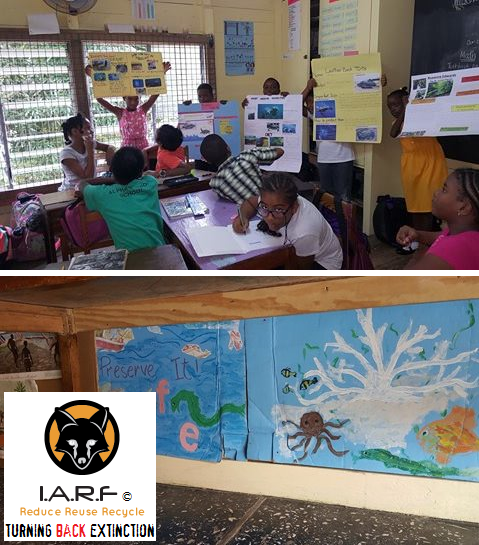
Image: School presentation, Grenada, West indies.
Around 150 bird species are on the island including the Grenada dove – one of the world’s most endangered bird. At the other end of the spectrum is the kite which, in the Caribbean, is widespread. There are a few havens for wildlife in Grenada, including Lake Antoine, Mount Hartman National Park, and the salt pond at the La Sagesse estuary.
To name but a few of the 150 species, birds you might see in Grenada include the limpkin, black-necked stilt, heron, mangrove cuckoo, tern, the common snipe, brown-crested flycatcher, Caribbean coot, northern jacana, three species of hummingbirds, cattle egret, frigatebird, boobies, bananaquit, mockingbird, osprey and the barn owl.
Sea turtles tend to nest at beaches in the north of Grenada, Bathways Beach is a favourite spot from March every year (in the Levera National Park). Giant leatherback turtles, hawksbill turtles, green turtles and, somewhat rarer, loggerhead turtles can be seen in Grenada.
Between the months of December and April in particular sees Grenada’s waters frequented by different whale species, including Orca (Killer) whales, Curvier beaked, humpback and Sperm whales. Around fifteen species in all have been logged which swim in the waters of Grenada. Year-round you can see Pilot, Bryde’s, Sperm, Pygmy and Sei whales. Several different varieties of dolphins can be spotted offshore too.
The large variety of fish in Grenada waters, to name some of them, include the yellow tail snapper, bar jacks, spotted drums, frogfish, scorpion fish, banded jaw fish, pipefish, grey angelfish, horse eye jacks, Atlantic spade fish, grouper, great barracuda, As well as seahorses, stingrays, Moray eels, spotted eagle rays and even Manta rays. For more information please click the link here.
Currently the problems of plastic waste littering the island of Grenada is considered very problematic - and to know these young children will be taking part in such an important international earth day environmental event, and are already eager to make change happen - is fantastic. The youth of Mt. Parnassus Junior School aren’t just setting an example, they are demonstrating their love for their island, flora and fauna - something many adults are still failing to at.
Given the islands’ geological and hydrological conditions, local stakeholders that are working to reduce Grenada’s waste problem expect that most of the plastic bottle litter as well as some of the plastic bottle landfill waste will sooner or later end up in the sea, negatively impacting the islands’ marine ecosystem. Furthermore as I speak nine endemic species of fish and five native birds are already on the verge of complete wild extinction. For more information please view the source here.
I’m so pleased and proud to know that children will be getting involved this April 22nd for the I.A.R.F.A Earth Day Event 2017 - Operation Beach Clean. If you are a school teacher and would like to organize a beach clean to conclude my ten year scientific study on marine and land animal deaths please contact me in person by clicking the link here.
More on the Grenada Beach Clean event will be made public soon. Watch this space.
With much thanks to Mandy, the school children participating, and for everyone that have unselfishly come forward to volunteer their time to clean our oceans on the biggest environmental event of the year.
Thank you.
Dr Jose C. Depre.
Environmental, Botanical and Human Scientist.
#OPERATION BEACH CLEAN | EARTH DAY - APRIL 22ND - APPLY HERE.
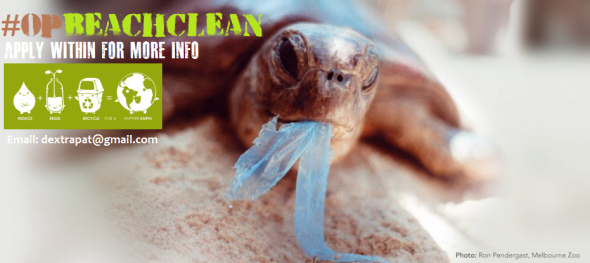
#OPBEACHCLEAN INTERNATIONAL
Saturday 22nd April 2017 I’ve decided to organize the biggest beach clean possible around the globe for Earth Day. The final straw came after I went through all reported aquatic deaths for 2012, 2013, 2014, 2015, 2016 and to date - 2017 only to find that nothing is improving relating to aquatic deaths declining, or waste on our beaches decreasing either. (Pic Credits: Ron Pendergast, Melbourne Zoological Society. Click the image above to be directed to our events site page on Facebook.com.)
The United States of America is now clocking up as the second largest country on the planet that’s reporting trillions upon trillions of mass fish deaths, dolphins, whales, false killer whales, crabs, and numerous aquatic sea birds too. The problem in America is now so concerning, that an immediate investigation has been launched to try and figure out just what is going on in the States of America.
The image below details the worst states hit for 2016. Florida is ranking as the worst with 14 mass aquatic deaths - that’s 14 reports from January to December 31st clocking up billions of fish, hundreds of birds and just under one hundred whales, and mostly dolphins. And if you think this is concerning wait for the next report.
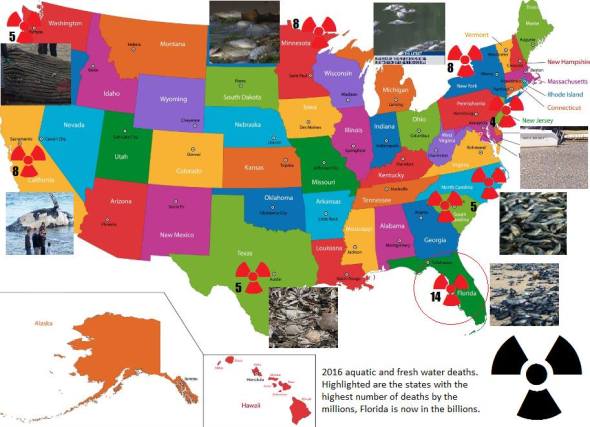
Image: Aquatic Death Mapping 2016. Click The Image For Further Info.
Don’t think for one minute neither that these are the only affected States of America. Every single state that has a shoreline reported deaths from the lowest being (1) mass death in the millions of fish, with the second lowest being (5) and as explained the highest (14.) Florida is the only state out of all fifty that is reporting a massive loss of marine and fresh water aquatic life. Scientists have been quoted as “left baffled by what’s going on in Florida.” I believe I know the answer, however require that final strand of evidence.
OPERATION BEACH CLEAN BY COUNTRY LIST SO FAR
- ENGLAND: (2 BEACH CLEAN OPERATIONS)
- AUSTRALIA: (1 BEACH CLEAN OPERATION)
- VIET NAM: (2 BEACH CLEAN OPERATIONS)
- OMAN: (1 BEACH CLEAN OPERATION)
- HOLLAND: (1 BEACH CLEAN OPERATION)
- THAILAND: (1 BEACH CLEAN OPERATION)
- UNITED STATES: (1 BEACH CLEAN OPERATION)
NB: The list above will be updated, for more information please click here: #OpBeachClean
I myself will be participating in the East Anglia region of Eastern Great Britain. Moreover there are a large number of volunteers that have already come forward to volunteer their time and effort cleaning our shorelines of waste that is unfortunately a contributing factor to many marine deaths globally.
QUESTIONS AND ANSWERS
Q: What time do I start my beach clean?
A: I’ve set my time for 09:00hrs however you can start when you want. Furthermore I’m going to be spending the best part of the day until sunset, however you can finish when you feel you’ve had enough, or if you’ve commitments to keep too and dependents to check on.
Q: What date is the event #OpBeachClean running on?
A: The date for #OpBeachClean is Saturday 22nd April 2017.
Q: Do I need to bring anything?
A: Yes, not too many things but obviously the basics. Checking the weather first before you depart, suitable clothing is a must. You’ll also need hard wearing gloves to keep your hands safe from glass, metals or syringes (etc.) Refuse bags, and if you feel its necessary - which I will highly suggest anyway, high visibility vests just so people know you’re about, working next to cycle paths, roads, or other busy areas too. Normal household weighing scales that you weigh yourself on to estimate the weight of each refuse bag for scientific documentation purposes. A clipboard and paper/notepad to document each piece of plastic, tin can, and clothing you retrieve (etc.) Finally food and beverages.
Q. Why do I need a notepad/clipboard and paper for?
A. I the event organizer require data relating to what you’ve retrieved to document within reports that will be presented to the United Nations, The Hague, and manufacturers too around the world. For example: If you retrieve 3 plastic bags, 5 beer cans, 20 tooth brushes, and 8 milk cartons, please document down the number of bags, cans, milk cartons (etc.) Furthermore if there is any identification on them objects such as (Tesco bag, Carlsberg beer, Unilever tooth brush, ASDA 2 pint milk carton.) Please document the name down next to the number of items like I have below.

Image: Example (1) Beach Clean Check List.

Image: Example (2) Beach Clean Check List.
NB: THE FOLLOWING DATA ABOVE I REQUIRE FOR DOCUMENTATION AND REPORTING TO THE RELEVANT GOVERNMENTAL DEPARTMENTS, AGENCIES, AND MANUFACTURES.
Q: Why do I need weighing scales for?
A: you’ll need weighing scales to weigh each bag, to conclude the final weight of each bag for reporting and research.
Q: Do I need a permit to clean a beach for free?
A: In all of the countries listed above, no you don’t require a permit. However in Thailand you may do.
Q: Will I need to take the waste to a refuse/recycling center?
A: If you can take the waste to a refuse/recycling center that would be great. However I will do everything I can to ensure the council or municipality either provide a skip for you, or inform them of where your waste has been dropped off for them to pick up.
Q: Can I change the date to a Sunday or after a public holiday?
A: In some countries such as Viet Nam public holidays are nearing for May. If you want to change the date for that time period then please do so, however please keep me informed.
Q: Can I take donations for your organisation?
A: Strictly no, I self fund my own organisation and do not rely on public funding. If you are a charity though non-related to myself that wish to take donations on behalf of your own charity/organisation then please remember you will need permission from the council in most cases.
Q: What if I need to cancel the event for reasons out off my control, can I chose another date?
A: Yes of course, I don’t see why not, as long as I’m provided with all the data required above, and we hit these beaches hard then so be it.
Q: What do I do if I locate a munition (Eg: WWI, WWII bomb?)
A: You call the POLICE IMMEDIATELY AND VACATE THE ENTIRE BEACH AS SOON AS POSSIBLE.
Q: What do I do about chemical containers, chemical leaks, spills or syringes?
A: Please leave all chemical containers where they are unless you’re qualified to remove with the relevant certification, if not then please inform your local environmental agency providing the location as soon as possible. In relation to syringes; your local chemist, medical surgery or hospital should provide you a free sharps box to place all syringes in safely. Please DO NOT pick the syringes up with your hands, but with a litter picker if you have one, and dispose safely. Once you’ve finished your beach clean please return the sharps box from where you was given it. If in the event you are pricked by a needle you’ll need to go straight to hospital or your local emergency medical doctor/nurse without delay!
Planet Earths beaches and rivers are becoming more polluted by the year. Aquatic marine deaths are skyrocketing, birds are dying at sea, whales, dolphins and crabs are washing ashore in the thousands and millions. The major problem we’re facing today though is plastic waste, drought, chemical spills, climate change, sonar, oil drilling, mining, dredging, sun exposure to the reef, rising sea temperature levels and even naval military exercises.
Human pollution though in the way of what you see in the video above, especially plastic, is one of the major concerns that threatens not just flora and fauna, but also the health of humans. Plastics gradually break down into micro-plastics of which are then eaten by smaller fish. human consumption of fish makes up a major part of our staple diet, and with plastic seeping dangerous chemicals into fishes bodies - its not just the fish we’re then consuming, but also the dangerous plastic toxins too.
To date Scientists still don’t know what the future holds in relation to these micro plastics, their toxins and how they’re going to affect human health. Marine and Human Scientists did warn though only last month that these chemicals are soon going to come back and haunt us in the way of cancers, diseases, and disorders.
Today, plastics accumulate in garbage dumps and landfills and are sullying the world’s oceans in ever-greater quantity. And plastics and their additives aren’t just around us, they are inside virtually every one of us— present in our blood and urine in measureable amounts, ingested with the food we eat, the water we drink and from other sources. And its all because of us, our obsession with plastic has in a sense turned into a nightmare, an addiction, everything we purchase is virtually plastic and 80% of the plastics we use, we only use once of which is then thrown away. That’s shocking.
“IF WE DON’T TAKE ACTION SOON, PLASTIC WILL OUT-NUMBER EVERY FISH IN THE OCEAN BY 2050”
To take part in #OpBeachClean please email here: [email protected] alternatively please contact me via my personal Facebook page here: Jose Please invite any friends and yourself to the event page on Facebook here: #OpBeachClean I would also like images of your work, a video diary too if possible, and any video/image shocking evidence of waste pollution you locate.
I do require the name of the beach your cleaning, coordinates, number of people, names of the event leaders, charities and organisations that will be taking part too. Once all data is sent into me by my email or via my personal email Facebook box I will submit each story online for Earth Day 2017, and communicate to the press and media too.
Finally all data you retrieve can be photographed and uploaded to me, emailed to me, or sent via post. The results from each beach clean will help me to better understand what’s going on within each stretch of ocean, how best to tackle the current problems, who to talk with relating to companies and their production of plastic materials, and government organisations of which I will be pushing with the evidence obtained from you ladies, gentleman and children for laws to be implemented, guidelines, charges and where necessary bans too.
Beaches that have little in the way of refuse bins, signage relating to no pollution, fine charges, will see me contacting the relevant environmental agencies, and councils to pull their finger out and begin caring more for our beaches and aquatic life. All other results will be presented in numerous graphs to the U.N, and Hague of which I will be without a doubt pushing for answers.
Any questions please email me below. Thank you to everyone that has come forward so far, what you’re all doing on the 22nd April isn’t just cleaning as I am, but your helping to make change happen, pushing for cleaner beaches, and answers from top governmental agencies.
Thank you.
Dr J. C. Depre.
Environmental, Botanical and Human Scientist.
ENDANGERED SPECIES MONDAY | SPOTTED SEAHORSE FACING EXTINCTION.
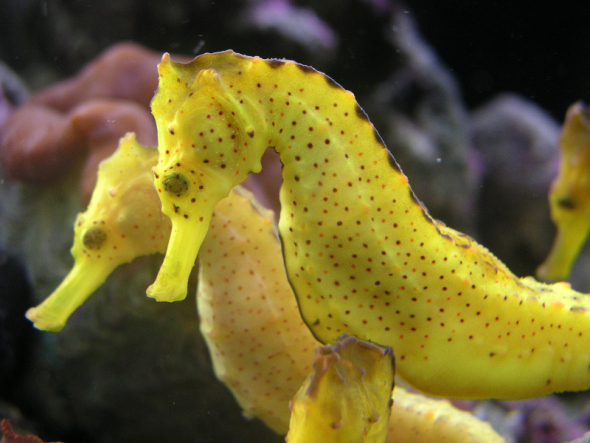
ENDANGERED SPECIES MONDAY | HIPPOCAMPUS KUDA
Once a common site within our oceans, the spotted seahorse (common seahorse) is facing extinction. The largest threat known is use and trade within the Traditional Chinese Medicine culture. As of 2015 its estimated that some twenty million (20 million) seahorses are used within the Traditional Chinese Medicine trade. (Photographer unknown).
Known in Mandarin as Hai Ma seahorses are believed to cure a wide spectrum of ailments and diseases and generally help to improve health. There is no evidence that I can locate to prove seahorses can improve human health in anyway shape or form. T.C.M practitioners have alleged seahorses can cure anything from asthma, arteriosclerosis, incontinence, impotence, insomnia, thyroid disorders, skin ailments, broken bones, heart disease, throat infections, abdominal pain, sores, skin infections.
Broken bones? Now that is about as ridiculous as it gets, impotence and broken bones are not illnesses but more physical complaints of which consuming seahorses is about as effective as pouring boiling hot water onto a third degree burn. A study in Taiwan located some fifty eight (58) sea horses from Taiwanese T.C.M vendors. A total of eight (8) different species were located. Seven (7) were listed as vulnerable, while one (1) was listed as endangered.
Source: http://www.jfda-online.com/article/S1021-9498(13)00043-4/abstract
The species listed as endangered was Hippocampus capensis commonly known as the Knysna seahorse (pictured below). The remaining seven (which doesn’t include the species pictured above) are scientifically identified as Hippocampus algiricus, Hippocampus comes, Hippocampus histrix, Hippocampus kelloggi, Hippocampus kuda, Hippocampus spinosissimus, and Hippocampus trimaculatus. If we include the species above - Hippocampus kuda this makes a total of eight (8) listed as vulnerable, and one (1) listed as endangered equating to nine (9) in total nearing extinction.
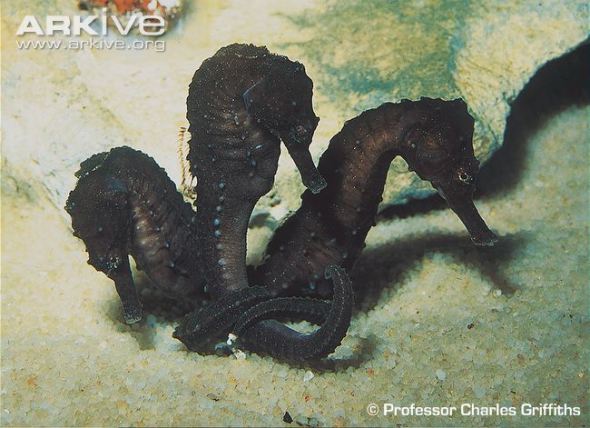
Image: Knysna seahorses | Credits Professor Charles Griffiths
Its quite possible there could be many more species of sea horses that haven’t been listed on the International Union for the Conservation Of Natures Red List [IUCN]. Hippocampus kuda was identified back by Dr Pieter Bleeker (July 10, 1819, Zaandam – January 24, 1878, from The Hague) whom was a Dutch medical doctor, ichthyologist, and herpetologist.
He was famous for the Atlas Ichthyologique des Orientales Neerlandaises, his monumental work on the fishes of East Asia published between 1862 and 1877. I don’t state this often however am going to repeat oneself again. Every single species of animal I’ve written about identified from the (1800’s) has almost all but gone extinct or are at least on their way towards extinction. Another pattern I have found is that many animals and plants used within the (T.C.M) trade were being used thousands of years ago - long before non-Asian travelers identified them. When the species are eventually identified - individual specie populations begin declining!
Since 1996-2003 the common seahorse has been listed as vulnerable, populations are declining very fast, furthermore there was little mentioned about the species at CoP17 in Johannesburg, South Africa; a country that is responsible for a large proportion of seahorse harvests. These harvests are legally shipped from South Africa into Asia, yet large numbers of seahorses are decreasing in South Africa.
I.A.R.F.A Environmental Crime Investigators located one legal trader identified as NGWABE TRADING that hosts a supplying ability of TWO HUNDRED METRIC TONS a month. When we inquired where these seahorses are harvested from, and the species caught we were not given a straightforward answer. NGWABE TRADING was though able to supply us with seahorses that have paperwork (all allegedly legal and above-board.) Yet we’re losing the vast majority of our seahorses. Furthermore I am very suspicious as to whether all of these seahorses are being harvested legally.
Two hundred metric tons per month is no different to two hundred metric tons of sand, cement, or rocks. On questioning the fishing company which I myself do suspect illegal poaching is going on here, many of these seahorses are dry traded to Asia. We’re talking big bucks too. So if this trade was restricted, or even banned, its likely South Africa would lose her seahorses in a matter of years, because legal farming operations wouldn’t be allowed if trade bans came into place. Meaning poaching would increase on a wide scale to supply Asia’s appetite for pseudo medicines.
Source: http://southafrica.tradekey.com/dried-sea-horses.htm
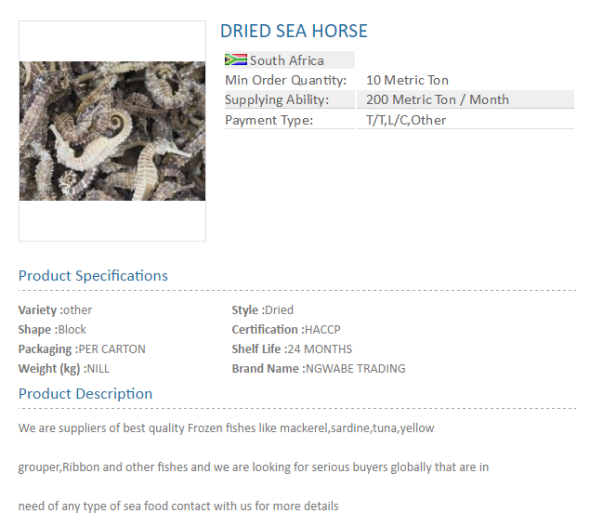
Image: One of many legal online seahorse/fish traders trading to Asia.
Seahorses are also used as an aphrodisiac and to facilitate childbirth in the T.C.M trade. As much as I want to disbelieve this, there is unfortunately “some scientific evidence” that does prove to a degree consuming a regular fish diet can improve sexual behavior within humans; however helping to conceive I am somewhat skeptical about. Sources are cited below for your information from the scientific community.
Source 1: http://www.pbs.org/wgbh/nova/seahorse/vincent.html
Source 2: http://www.acupuncturetoday.com/herbcentral/sea_horse.php
Between twenty (20) and forty (40) million seahorses are allegedly harvested every-year for the T.C.M trade, however if we go on the amount of trade originating from South Africa - its obvious that by the ton load this number is seriously under-quoted. If I myself was purchasing the minimum ton load of ten (10) tons per month - that would easily equate to over twenty (20) and forty (40) million seahorses per annum based on twelve (12) months.
So I think its safe to say we’re looking at possibly hundreds of millions rather than the claimed IUCN stats. I must also note that the spotted seahorse is listed on Appendix II, and to date we will never really know how many seahorses remain within their endemic range, or how many are illegally harvested?
The common seahorse in question which is the species harvested the most for the T.C.M trade is endemic to the following regions: American Samoa (American Samoa); Australia (Northern Territory, Queensland); Bahrain; Cambodia; Fiji; French Polynesia; Hong Kong; India; Indonesia; Japan; Kuwait; Malaysia; Micronesia, Federated States of ; Mozambique; New Caledonia; Pakistan; Papua New Guinea; Philippines; Saudi Arabia; Singapore; Solomon Islands; South Africa (KwaZulu-Natal); Taiwan, Province of China; Tanzania, United Republic of; Thailand; Tonga; United States (Hawaiian Is.); and Viet Nam.
Endemic ocean locations are: Indian Ocean – western; Indian Ocean – eastern; Pacific – western central; Pacific – northwest; Pacific – eastern central.
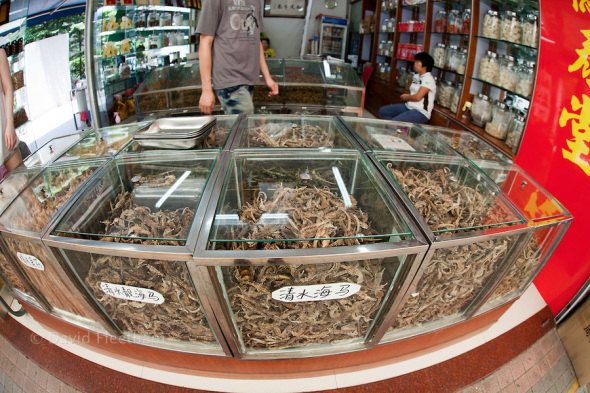
Image: Dried Seahorses for sale, China | Credits David Fleetham
THREATS
Common threats are cited above in more detail. Major threats though are listed below for your immediate attention:
Hippocampus kuda is threatened by damage to its habitats from coastal development and destructive fishing practices. Land-based activities such as coastal construction can diminish seagrass beds and mangroves while leading to increased pollution and siltation in surrounding marine waters. For example, in Malaysia Hippocampus kuda numbers declined due to an extensive port development around the Pulai Estuary that destroyed large tracts of seagrass meadow.
Fishing methods such as trawling result in substantial damage to seagrass beds globally, and especially in the Indo-Pacific. The decline in and fragmentation of the species’ habitats throughout its range indicates possible declines in populations in addition to those caused by fisheries.
All seahorse species have vital parental care, and many species studied to date have high site fidelity, highly structured social behaviour, and relatively sparse distributions. These life history parameters often make species susceptible to exploitation as has been demonstrated for a number of species, including seahorses. Although seahorses also have some traits, such as small body size, fast growth and high fecundity, that may confer resilience to exploitation pressures.
Due to the mode of spawning exhibited by Hippocampus kuda (ovoviviparous brood pouch male parental care), fecundity is comparatively low compared to non-brood pouch spawning fishes and therefore its capacity for population growth is more limited than other species. As a result of the lack of broadcast spawning of pelagic eggs, dispersal of potential recruits is limited. Additionally, given the limited swimming abilities of seahorses, it is highly unlikely that rescue effects would occur from adjacent populations.
Concluding: I am somewhat concerned about the species future survival. CITES is allowing use and trade however those countries that are listed under the convention are allegedly strictly regulated and monitored - I don’t call ten tons per month from one South African company strict regulation. Countries that are importing/exporting must prove they have permits, however I don’t quite understand how this area of monitoring is working - which it clearly isn’t as the seahorse trade is colossal within many Asian countries and South Africa too.
Hippocampus kuda is listed as vulnerable in the National Red Data Books of Singapore and Thailand, and endangered in the Red Data Book of Viet Nam. In France it is illegal to import seahorses under the name H. kuda.
The future is bleak unfortunately and with trade so fanned out, and from what I have seen on my visits to Asia (increasing) I do honestly believe we’re going to be reporting extinctions in the ‘very near future.’ To date there are thirty two (32) identified species of seahorses. Ecologically, they are important in food chains, consuming tiny fish, small shrimp, and plankton, and being consumed by larger fish (such as tuna and rays) and crabs. So if we lose the seahorse we lose yet another vital source of food for endangered tuna species, rays, crabs, and even whales (Etc.)
Source: http://www.newworldencyclopedia.org/entry/Seahorse
Thank you for reading and please share to create awareness and to improve education.
Dr Jose C. Depre.
Environmental, Botanical & Human Scientist.


